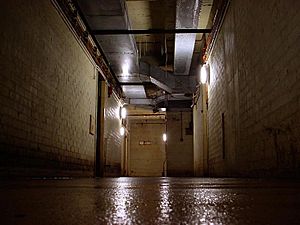Paddock (war rooms) facts for kids
Quick facts for kids Paddock |
|
|---|---|
| Part of Cabinet War Room | |
| 109 Brook Road, Dollis Hill, London, NW2 7DZ in England, United Kingdom | |

The main corridor of the Paddock bunker
|
|
| Lua error in Module:Location_map at line 420: attempt to index field 'wikibase' (a nil value). | |
| Coordinates | 51°33′44″N 0°14′19″W / 51.562194°N 0.238586°W |
| Type | Bunker |
| Site information | |
| Owner | originally: HM Government now: Network Homes |
| Controlled by | originally: War Cabinet |
| Open to the public |
Yes; 2-3 times per year |
| Condition | Partially preserved |
| Site history | |
| Built | January 1939 |
| Built by | Ismay & Hollis |
| In use | 1944 |
| Materials | Reinforced concrete |
| Fate | Decommissioned |
| Battles/wars | World War II |
Paddock was a secret bunker used during World War II. It was a backup command center for Winston Churchill and his government. This hidden place is located in Dollis Hill, northwest London. Its secret name, Paddock, came from a nearby road. That road was named after an old horse farm called Willesden Paddocks.
This special bunker was built deep underground in 1939. It was made from reinforced concrete, which is extra strong. The construction was kept completely secret. Paddock was rarely used during the war. Only two important meetings of the War Cabinet (the main government group) happened there. The bunker was no longer needed after 1944.
Contents
What is Paddock?
Paddock is a large underground space. It has about forty rooms spread across two floors. Today, it is a bit run-down. You can still see original equipment inside, but it is rusty. Sometimes, water leaks into the bunker. An electric pump helps to keep the water out.
Paddock's History
Building a Secret Bunker
The Paddock bunker was built in 1939. It was designed to be bombproof. This meant it could protect important people from bombs during the war. The bunker is located about 40 feet (12 meters) underground. It was a very secret project.
Use During World War II
Even though it was built for safety, Paddock was not used very often. Most of the time, Churchill and his team worked from the main Cabinet War Rooms. These were closer to central London. Paddock was a backup plan in case the main rooms were damaged.
After the War
After World War II ended, Paddock had new uses. The Post Office used it for research. Their staff also used it for social events. In 1976, the Post Office moved out. Paddock then sat empty for many years.
Paddock Today
In 1997, a group called Network Homes bought the site. This group builds homes for people. Paddock is now owned by them. For a while, the bunker was open to the public. People could take free guided tours a few times a year. These tours were given by volunteers from a group called Subterranea Britannica. Paddock was even shown on a TV show called Underground Britain.
See also
- Military citadels under London

